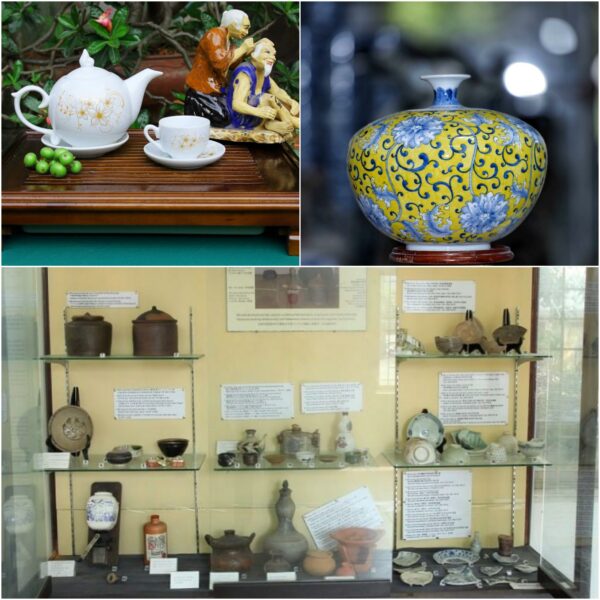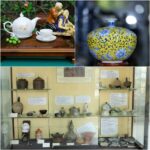Kim Lan village is located in Kim Lan commune, Gia Lam district, about 30km away from the center of the Capital. Its North borders the ancient village of Bat Trang, its West borders Hoang Mai district. According to folklore, Kim Lan village is named Suon village (as Sino-Chinese). During the 18th Hung King period, Princess Tien Dung from Viet Tri capital, followed the Red River through Kim Lan village, saw the charming landscape, stopped to rest before returning to Chu Xa village to meet Chu Dong Tu. In AD 40, an army of Hai Ba Trung from Luy Lau gathered at Kim Lan village and then continued to cross the Red River to hunt the enemy.
Through the excavation of precious artifacts at the Ham Rong site in 2001 and 2003, the Institute of History, Archaeological Institute, Museum of History concluded that pottery production in Kim Lan dates from the 8th century to 18th century. Since the eighth century, Kim Lan pottery has been classified as a precious product along with silk, brocade, pearls and jade. Not only having valuable products, but Kim Lan also has rustic and simple pottery. During the flourishing period, to the eighteenth century, the pottery profession in Kim Lan gradually faded. Concerned about ancient pottery from 1977-1978, people in Kim Lan village started to “re-operate” the old pottery kilns. The pottery village is gradually revived. Up to now, hundreds of households in Kim Lan have their own ceramic kilns, creating jobs and income for people.
If Bat Trang is famous for its fine art pottery, Kim Lan is considered the hometown of household wares. What makes Kim Lan pottery different is that its products are not fussy, but simple, harmonious, and convenient. Products of the pottery village are plentiful and diverse, from small sizes such as toothpicker boxes, candlesticks to large sizes such as pickles, pots, bonsai pots… In addition to dishes, pots and common items in daily life, the pottery artists Kim Lan also produce valuable products such as vases, pots, temple lamps… with two types of traditional glaze, crackle glaze and celadon glaze. In addition, it also focuses on developing ceramic products for construction such as bricks, decorative tiles, rollers… Kim Lan pottery village today offers a variety of high-quality products, not only serving needs domestic demand of major markets in the world such as Japan, Korea …
Ancient Kim Lan pottery is famous for being meticulously handcrafted in each step. Finished shaping products immersed in mixed water, made from natural materials such as rice husk ash, powdered lime, crushed stone powder or white soil, then, baked will produce the finished product with clear white and soft smooth enamel. Reducing the amount of rice husk ash creates crackle glaze. Now, with modern technology and supporting chemicals, the potters can make enamel easily without manually, but still, strictly follow the traditional production process. Previously, most of the pottery production facilities in Kim Lan village used coal kilns for burning, but in recent years, switched to gas kilns, contributing to reducing environmental pollution, saving energy, and increasing high production efficiency. Thanks to technology conversion, more than 80% of CO2 emissions are reduced and about 70% of energy consumption is saved.

Ceramic products today (top row) and precious ancient pottery artifacts (bottom row) – pride of the people of Kim Lan.
Coming to this old pottery village, visitors also have the opportunity to visit an attractive site, which is the Kim Lan Commune Museum of Ceramics and History. The museum is located adjacent to the communal People’s Committee campus with an area of about 200 square meters, with a stylized roof in the style of a round furnace and a vertical kiln as traditional ceramic kilns of Kim Lan people. The museum is founded from the love and enthusiasm of many generations of Kim Lan people and domestic and foreign scientists who are attached to archeology here. Collecting antiques and building a museum of ancient pottery by seniors in the group “Tìm về nguồn cội” of Kim Lan village and Japanese doctor Nishimura Masanari was awarded the Job – For Love to Hanoi at the awarding ceremony of Bui Xuan Phai Award – For Love to Hanoi for the 6th time in 2013. The museum displays more than 300 rich and valuable ceramic artifacts such as curved tiles, decorative brick with phoenix bird pattern; ancient ceramic pots and bowls; celadon glaze bowls; Bricks carved with Chinese characters…
Spending time walking along the quiet village streets, visiting traditional ceramic production facilities, learning about the pottery making process or finding unique products will be a truly enjoyable experience for travelers to Kim Lan.
Ngan Ha

